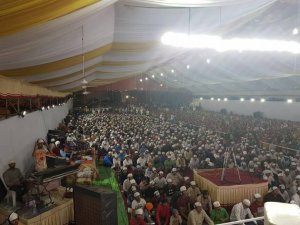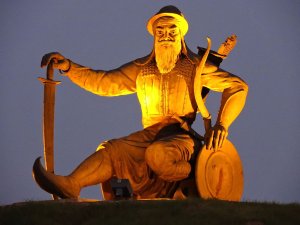Introduction
A ruined structure in Sirhind known as Jahazi Haveli which was built like the shape of a ship is attributed to be the mansion residence of Diwan Todarmal who performed the cremation of younger sons of Guru Gobind Singh and their grandmother following their martyrdom in December 1704/05. Some repairs were done more than a decade ago and then stopped. This short article tries to explore the history and ownership of the Jahazi Haveli.
Visit to Sirhind in 1822
On 1st April 1822, Major Sir William Lloyd and Captain Alexander Gerard visited the old fort in Sirhind, which was of moderate dimensions and built of bricks but in a ruinous state. In it were the 'tombs of Guru Govind (Singh)'s mother, and of his two children, who were cruelly put to death'. The author writes although the tombs are plain, 'the sepulchres' are often visited by Sikh pilgrims, and 'it is said that five hundred of the sect constantly perform the duties at them.'
This is one of the earliest recorded visits to the site and a few years later a Gurdwara Sahib was built by Maharaja Karam Singh (r.1813-45). Sadly, it makes no mention of Diwan Todarmal or Jahazi Haveli but an important slice of the history of this region. (1)
Archaeological Survey of India Report 1864
Subhash Parihar is a well-known name in academic circles for his work on Islamic-era structures, architecture, and their history in the Greater Punjab region. One of his works, History & Architectural Remains of Sirhind was published in 2006. In this book, he quotes Alexander Cunningham who refers to Jahazi Haveli as the Haveli of Sahabat Beg or Sandik Beg. Unfortunately, nothing is known about Sahabat Beg or Sandik (Sandiq) Beg.
Dr. Parihar adds that the 'large span and almost flat-headed profile of the entrance arch' of the Haveli indicate its erection in the mid-seventeenth century. The academic further states that the land where this Haveli stands is the property of the daughter-in-law of Raja Shivdayal Singh, a member of the Council of Regency during the childhood of Maharaja Bhupinder Singh (birth October 1891, crowned in 1900) of Patiala. (2)
Cunningham who visited in 1863/64 writes ‘The Haveli or dwelling house of Sahabat Beg, or Sandik Beg, is only worthy of notice as, perhaps, the largest existing specimen of the ugly domestic architecture of the wealthy Muhammadans of the Mogal Empire.’ (3)
Alexander Cunningham was appointed the Archaeological Surveyor in 1861. He founded and organised the Archaeological Survey of India. He wrote numerous books and due to his immense contribution, he is considered to be the father of Indian Archaeology. The stature of Cunningham meant that this assertion that the Haveli belonged to Sahabat Beg made it to tourism books as well.
Other documentation in the British Era
London-based John Murray publishing house when they produced a handbook for potential tourists to Punjab (4) and India (5) repeated the Cunningham statement but removed the word ‘ugly’ to describe this Haveli.
Chas J Rodgers discusses the Haveli of Sahabat Beg in The Report of the Punjab Circle of the Archaeology Survey for the year 1888-89. Dr. Parihar refers to it in his write-up on Jahazi Haveli. (6)
However, Rodgers did not include the Haveli when he composed the Revised List of Objects of Archaeological Interest in Punjab in 1891. (7)
The Punjab State Gazetteers 1904 Phulkian States provides just one line, ‘here (Sirhind) is also a Jahazi Haveli built on the model of a ship.’ (8)
Post-independence documentation
The Census of India 1951 for district Fatehgarh Sahib copies and quotes the said Gazetteers in the introduction chapter and repeats the same line on Jahazi Haveli. (9)
In 1972 Punjabi University, Patiala published the book titled Sirhind through the Ages edited by Fauja Singh. The book had articles by eminent historians on Sirhind in some detail.
Fauja Singh & M.S. Ahluwalia in the article ‘Some Eminent Administrators & High Officials of Sirhind’ wrote without providing any reference that ‘his (Todarmal Shahjahani) magnificent mansion called Jahazi Haveli today even in its ruins presents a very impressive view.’ (10)
Kirpal Singh (& Fauja Singh) in the article 'Monuments of Sirhind' in the same book takes a slightly more cautious approach to Jahazi Haveli and writes ‘its construction is attributed to Dewan (Seth) Todar Mai who during the Mughal period, by dint of merit, got quick promotions and rose to be the Amin or Karori (according to some accounts even the Faujdar) of Sirhind.’ (11)
The Maathir ul Umara contains the biographies of Muslim and Hindu officers under the Mughals till 1780. Shah Nawaz completed it in around 1759 then his son Abdul Hayy added additional biographies and completed the second edition of the manuscript in 1780. This manuscript states that Todarmal Shahjahani died in 1665-66. (12) Hence it would not have been possible for him to make arrangements for the cremation of the younger sons of Guru Gobind Singh and their grandmother after their martyrdom in December 1704/05.
Ganda Singh writing for the journal The Panjab Past and Present in 1985 is silent on the ownership. He describes Jahazi Haveli as a 'building of architectural importance, raised to represent the shape of a ship (Jahaz). Most of it is gone. The remaining portion is in a dilapidated condition.’ (13)
Punjab District Gazetteers for Patiala published in 1992 refers to the structure as ‘Jahazi Haveli of Seth Todarmal’ again without providing any reference. (14) This Gazetteer refers to the book Sirhind through the Ages and makes the same error of attributing the cremation of younger sons of Guru Gobind Singh and their grandmother to Todarmal Shahjahani. It must have been a namesake who lived in Sirhind around 1705.
Sirhind was not a province
In most books written by Punjabis, it is erroneously stated Sirhind was a Suba (or province) and Wazir Khan was the Subedar (Governor). In fact, Sirhind was a Chakla or Sarkar which was an administrative division under a province or suba and akin to a district.
Encyclopaedia of Sikhism (15) and many Sikh historians like J.S. Grewal (16), Bhagat Singh (17), and Surjit Singh Gandhi (18) correctly denote Wazir Khan as the Faujdar of Sirhind.
Ahkam-i-Aiamgiri (Orders of Aurangzeb) is a collection of orders (farmans) issued following the instruction of the Mughal Emperor Aurangzeb. It contains four orders relating to Sikhs and is addressed to Wazir Khan. Sirhind is referred as Sarkar. One of the orders, widely quoted refers to Guru Gobind Singh Ji’s two sons and other companions being killed at the village of Chamkaur and one son (the transcriber was mistaken, it was two sons) and his mother being captured. (19)
Wazir Khan was not an ordinary Faujdar but with additional powers. Akhbar-i-Darbar-Mualla is the Mughal court newsletters. The ones relating to Punjab from 1707-18 were translated by Bhagat Singh in 1984. The newsletter dated 1st December 1707 mentions Wazir Khan as Faujdar and Amin of chakla of Sirhind who had a mansabdari rank of 5000 zat and 4000 swar (cavalrymen). The rank of 2500 zat and 1300 swar was exempted from any conditions and obligations to the state. (20)
Tazkiratu Salatin Chaghata states Wazir Khan descended from Wazir Khan Akbar Shahi (a noble under Akbar). The manuscript further adds that Suchanand was his Peshkar (chief clerk) and Rustam Dil Khan was appointed Faujdar of Sirhind after Banda Singh Bahadur’s defeat at Sirhind in late 1710. (21)
Muhammad Qasim’s Ibratnama of 1723 mentions Suchadanand, Chief Clerk (Peshkar) of the late Wazir Khan. (22) Mirza Muhammad in his Ibratnama written in 1719 refers to Wazir Khan as Amin and Faujdar of chakla Sirhind. (23)
As late as 1763 during the Durrani – Sikh struggle, the Persian sources state the head of the division, Zain Khan as Faujdar of chakla Sirhind. (24)
Conclusion
The writer of this article does not claim to have studied all the books and articles on Jahazi Haveli of Sirhind. However, during the British era, it was not attributed as a non-Muslim building. The book Sirhind through the Ages published in 1972 seems to be the first work that refers to Diwan Todarmal as the owner of Jahazi Haveli without providing any reference for this assertion.
The old timers and elderly of Sirhind recall that the Jahazi Haveli, as they were told by their parents and grandparents was a Haveli of a rich Muslim.
A mid-seventeenth century building irrespective of its origins should be preserved however the public (especially Sikhs) sentiments should be taken into consideration, who feel aghast at what they see as the apathy of the authorities in conserving the Jahazi Haveli of Diwan Todarmal. The Archaeological department of the Government of Punjab and Shiromani Gurdwara Parbandhak Committee should investigate this matter and share any updated research on Jahazi Haveli.
It is not uncommon that some errors creep into verbal traditions over a period of time. This has been the case with Sirhind which has been referred to as Suba or province in verbal traditions but was Sarkar or Chakla. It is never too late to correct an error.
*The writer is the author of the book, Afghan Hindus & Sikhs History of a Thousand Years
Originally published in Abstracts of Sikh Studies Journal issue July - Sept 2023.
References
- William Lloyd & Alexander Gerard (1840) Narrative of a Journey from Caunpoor to the Boorendo Pass in the Himalaya Mountains via Gwalior, Agra, Delhi & Sirhind. Vol 1 London: J. Madden & Co. p74-75
- Subhash Parihar (2006) History & Architectural Remains of Sirhind. New Delhi: Aryan Books International p209
- Alexander Cunningham (1871) Archaeological Survey of India Four Reports made during the years 1862-63-64-65 by Vol II. Simla: Government Central Press p211
- Handbook of the Panjab, Western Rajputana, Kashmir & Upper Sindh, 1883 London: John Murray p170
- A Handbook to India, Burma & Ceylon. John Murray, London, 1898 (3rd edition) p195
- Subhash Parihar op. cit. Chas J Rodgers (1891) Revised List of Objects of Archaeological Interest in Punjab. Lahore: W.Ball & Co. p55
- Punjab States Gazetteers Vol XVII. A 1904 Phulkian States. Lahore: Punjab Government, 1909 p209
- Census of India 1951 Pepsu District Census Handbooks Vol 5 District Fatehgarh Sahib. Simla: Pepsu Government pV
- Fauja Singh (1972) Sirhind through the Ages. Patiala: Punjabi University p80
- Ibid. p142
- Baini Prashad (1952) The Maathir ul Umara by Shah Nawaz Khan. Translated by H. Beveridge. Vol 2. Calcutta: Asiatic Society. p958
- Ganda Singh (1985) Some Important Towns of PEPSU. The Panjab Past & Present. Vol. XIX-I p244
- Gazetteer of India Punjab Patiala. Chandigarh: Punjab Govt. 1992 p633
- Please see the entry of Wazir Khan in the Encyclopaedia of Sikhism
- J. S. Grewal (1967) Guru Gobind Singh A Biographical Study. Chandigarh: Panjab University pX, 138, 145, 150, 161
- Bhagat Singh (1984) Akhbar-i-Darbar-i-Mualla. The Punjab Past & Present. Vol XVIII-II p24,26
- Surjit Singh Gandhi (1999) Sikhs in the Eighteenth Century: Their Struggle for Survival and Supremacy. Amritsar: Singh Brothers p30
- J.S. Grewal & Irfan Habib (2001) Sikh History from Persian Sources. New Delhi: Tulika p97
- Bhagat Singh op. cit.
- J.S. Grewal & Irfan Habib op. cit. p143-144
- Ibid. p116
- Ibid. p134
- Ibid. p190








